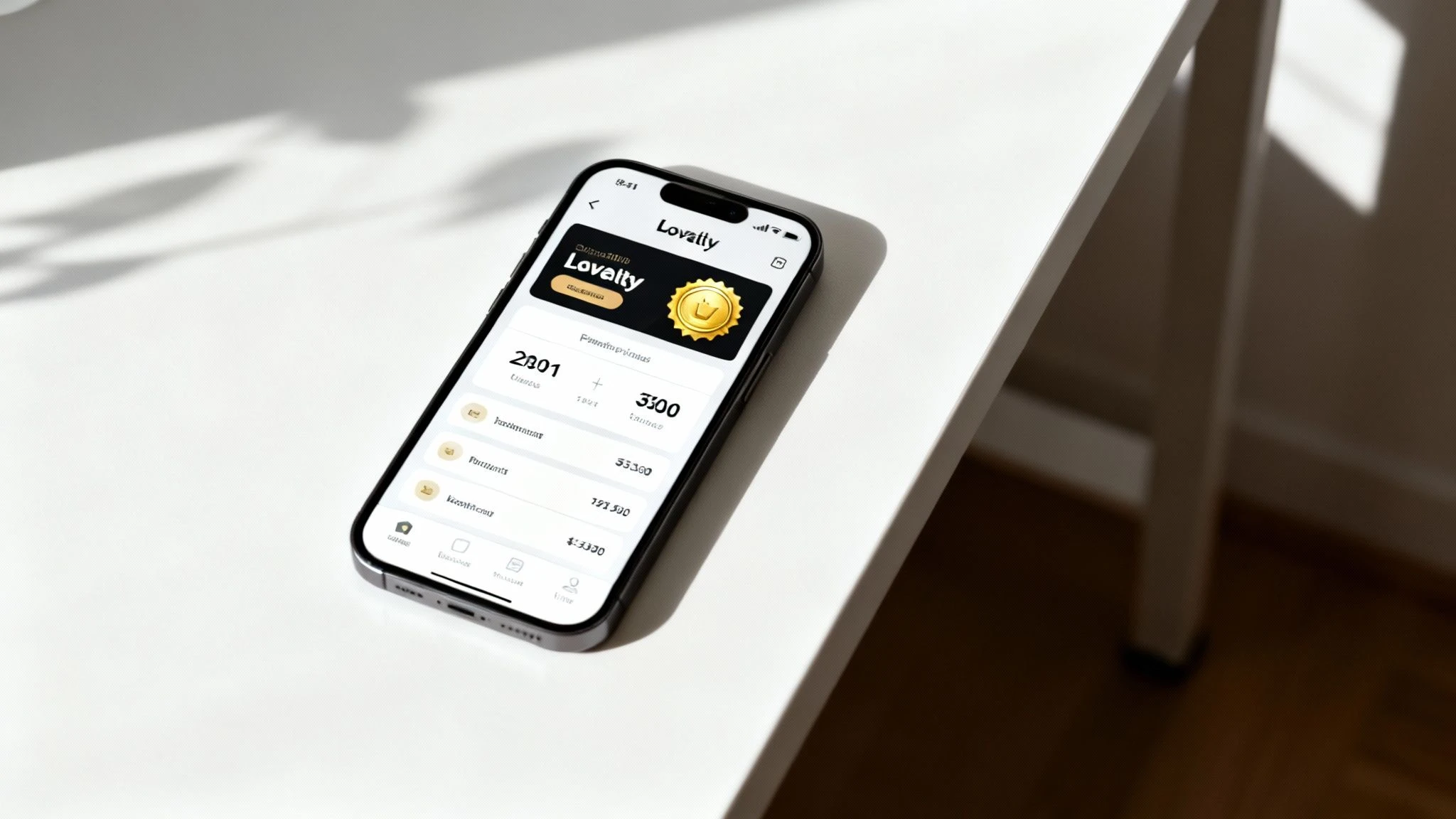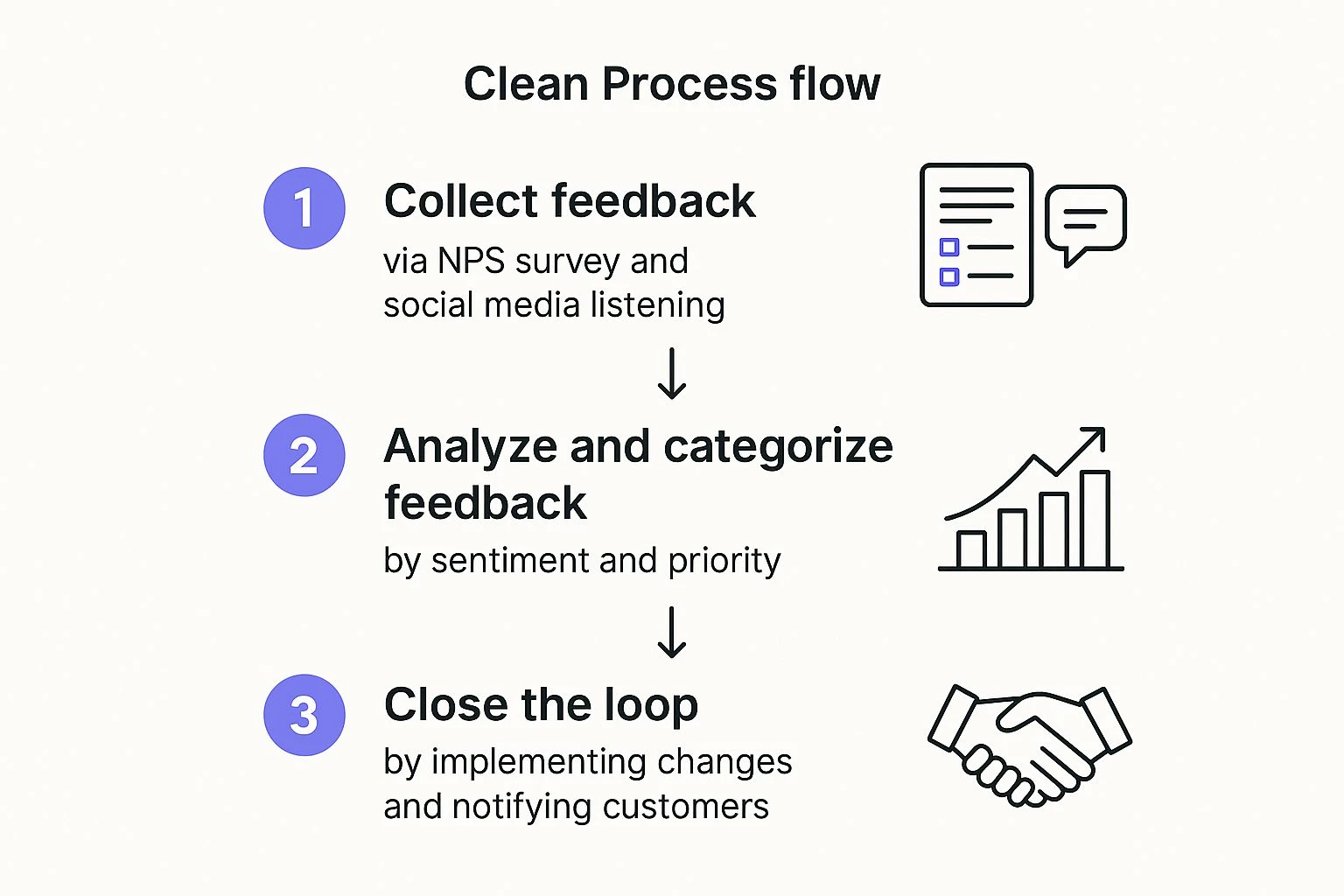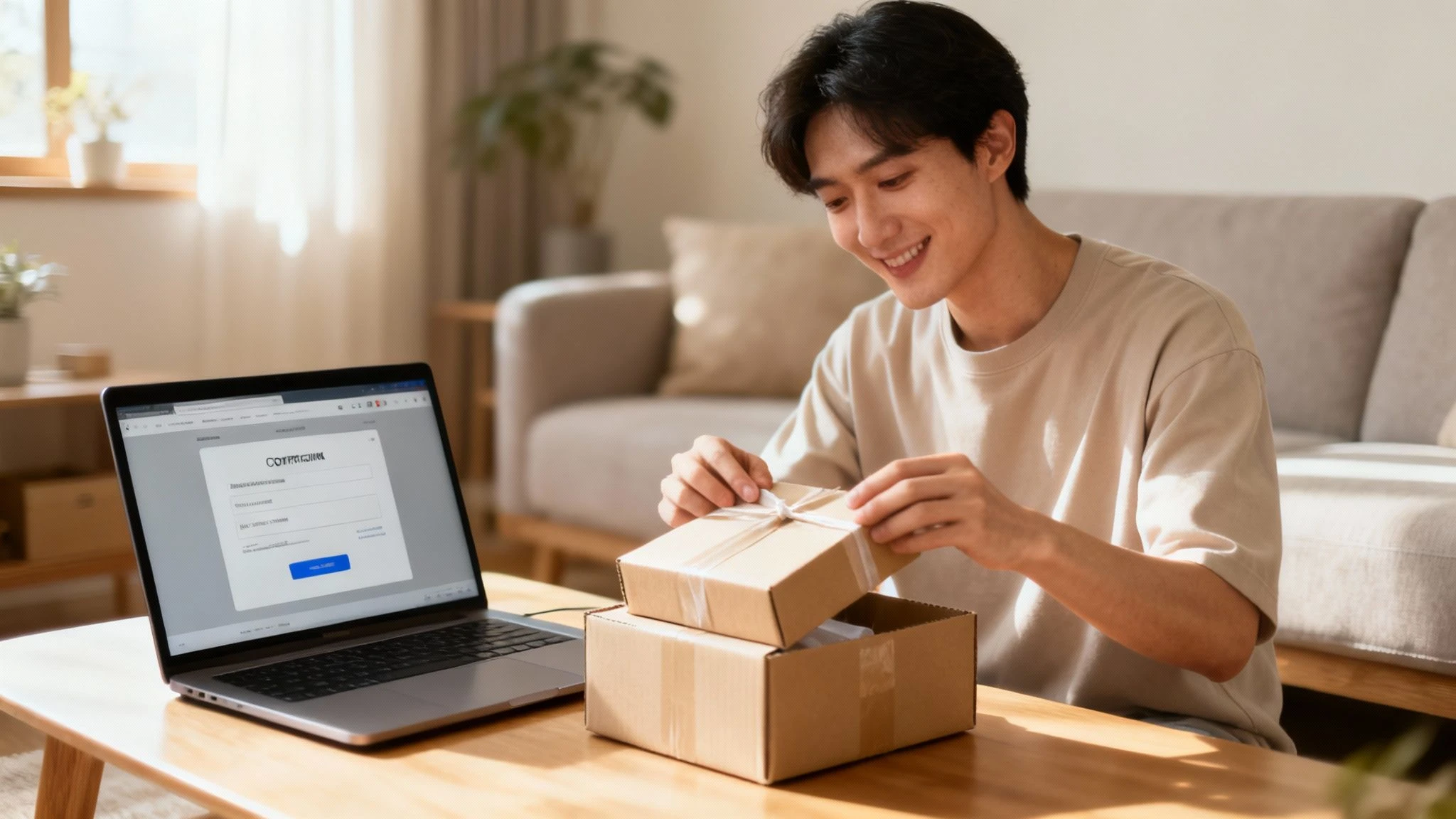Keeping customers around comes down to a simple, powerful idea: make them feel so valued they wouldn't think of going anywhere else. It’s about building real, lasting relationships that go way beyond a single transaction.
This means shifting your focus to personalized communication, exceptional service, and rewarding loyalty. When you get that right, one-time buyers transform into your loudest and most passionate advocates.
Why Your Best Customers Are the Ones You Already Have
So many small businesses get stuck on the "acquisition treadmill," constantly chasing new leads while ignoring the goldmine right in front of them. Of course, getting new customers is important. But focusing only on that is like trying to fill a leaky bucket.
The smartest path to sustainable growth is to nurture the relationships you've already built.
Understanding how to keep customers isn't just a feel-good tactic; it's a powerful financial strategy. Think about it: your current customers have already taken a leap of faith and bought from you. They know your products, they get your value, and they're far more likely to buy again than a cold lead.
The Financial Power of Loyalty
The numbers don't lie. A tiny 5% increase in customer retention can boost your profits by a massive 25% to 95%.
How? Because loyal customers don't just stick around-they spend more. On average, an existing customer will spend 67% more than a new one. They're cheaper to market to, they buy more often, and their lifetime value just keeps growing.
Focusing on retention shifts your mindset from short-term sales to long-term value. Every positive interaction, personalized offer, and resolved issue compounds over time, building a foundation of loyalty that competitors can't easily replicate.
Building a Foundation for Growth
Think of your loyal customer base as your business's immune system. They provide a steady stream of revenue, give you honest feedback when you need it most, and become your best marketing channel through word-of-mouth.
To dig deeper into this, you might want to explore some proven strategies for improving customer lifetime value. Before we jump into the "how-to," let’s get a quick overview of the core strategies we'll be covering.
Core Customer Retention Strategies at a Glance
This table breaks down the key approaches we're about to explore. It’s a simple snapshot of where to focus your energy and the kind of actions that make a real difference.
| Strategy | Primary Goal | Key Action |
|---|---|---|
| Loyalty Programs | Reward repeat business & increase purchase frequency. | Implement a simple points-for-purchase or tiered rewards system. |
| Personalization | Make customers feel seen and understood. | Use purchase history to send targeted emails with relevant offers. |
| Customer Feedback | Show you listen and are committed to improving. | Proactively send post-purchase surveys and respond to reviews. |
| Touchpoint Optimization | Create a seamless and positive brand experience. | Streamline your checkout process and offer multiple support channels. |
Each of these pillars works together to build a business that customers don't just buy from, but truly connect with. Let's break down how to put them into action.
Create a Loyalty Program People Actually Use

A loyalty program is one of the most powerful ways to reward your best customers, but let’s be real-the days of flimsy paper punch cards are long gone. To actually build loyalty, your program needs to feel less like a transaction and more like a genuine thank you. It has to offer real, achievable rewards that get customers excited to come back.
The idea is to get a simple cycle going: they shop, they earn, and the rewards they get bring them right back to your door. This isn't just a hunch; 59% of sales leaders point to loyalty programs as their top retention strategy. It makes sense, especially when you consider loyal customers are about 70% more likely to make another purchase.
That link between a great program and repeat business is exactly why this strategy is so critical.
Designing Your Program Structure
Before you start printing anything or looking at apps, you need a solid plan. The best programs are dead simple to understand and easy for everyone-you and your customers-to track. There's no one-size-fits-all model here; the right choice comes down to your business and what your customers actually care about.
Most successful programs fall into one of these buckets:
- Points-Based Systems: Customers earn points for every dollar they spend, which they can cash in later for discounts or free stuff. This is a classic for a reason-it’s easy to grasp and directly rewards spending.
- Tiered Programs: This is where you add a bit of a game to it. Customers unlock better perks as they spend more, moving up from "Silver" to "Gold" status, for example. A Silver member might get early access to sales, while a Gold member gets that plus free shipping. It gives people a goal to shoot for.
- VIP Clubs (Paid or Invite-Only): This model offers immediate, high-value benefits to members who either pay a fee (think Amazon Prime) or are invited based on their history with you. It creates a powerful sense of exclusivity.
For a small business, a simple points system is often the easiest way to get started and see results quickly. If you want to dive deeper, check out these golden rules for setting up a successful loyalty program with points.
Choosing Rewards That Resonate
Here’s the thing: your program is only as good as its rewards. If the prizes feel cheap or totally random, you won’t inspire anyone to stick around. You have to offer perks that your specific customers will actually get excited about.
The best rewards aren't always the most expensive. They're the ones that make your customer feel seen and special. An exclusive experience or early access can build more loyalty than a simple 10% discount ever will.
Think beyond just knocking a few bucks off the price. While everyone loves a discount, getting creative can build a much stronger connection to your brand.
Try mixing in rewards like these:
- Free Products: A free coffee after buying ten, or a complimentary appetizer on their next visit. Simple, but effective.
- Exclusive Access: Let them be the first to shop a sale or get a sneak peek at new products.
- Experiential Rewards: Invite your best customers to a members-only workshop, a special tasting event, or an after-hours party.
- Partner Perks: Team up with a neighboring, non-competing business to offer a cross-promotional discount.
When you nail the structure and offer rewards people genuinely want, your loyalty program stops being a marketing expense and becomes one of your best tools for keeping customers for life.
Master Personalized Customer Communication
Let's be blunt: generic, one-size-fits-all marketing is a direct flight to the spam folder. If you really want to know how to keep customers around, you have to make them feel seen, heard, and valued-like individuals, not just numbers on a spreadsheet. The real connection begins where you go beyond just plugging their first name into an email.
Thoughtful personalization shows you’re paying attention. It tells them you understand their needs and genuinely appreciate their business. This isn't about getting bogged down in complex algorithms; it's about using the information you already have to create a better, more relevant experience. When you get this right, your messages stop being an interruption and start feeling like a welcome conversation.
Go Beyond the First Name
True personalization is all about behavior and preferences. The goal is simple: send the right message to the right person at the right time. That journey starts with organizing your customers into meaningful groups based on what you know about them.
This practice, known as segmentation, is your secret weapon for crafting messages that actually hit home. Instead of blasting your entire list with a generic sale, you can create targeted campaigns that feel uniquely relevant to each person. To really dig into this, you can learn more about creating powerful customer segments and see how they drive serious loyalty.
Here are a few simple but incredibly effective ways to segment your audience:
- Purchase History: Group customers by what they've bought. Someone who frequently buys coffee beans might actually be interested in that new espresso machine you just got in. The person who only buys tea? Probably not.
- Purchase Frequency: It's smart to separate your regulars from your first-timers. A "welcome" discount for a new customer is great, but a "we miss you" offer for someone who hasn't been back in a while can be even more powerful.
- Customer Lifetime Value (CLV): Pinpoint your top spenders and give them the VIP treatment they deserve. This could mean exclusive early access to new products, special event invitations, or a dedicated support line.
Celebrate Milestones and Show You Care
Personalization isn’t just about making the next sale. It's about building a genuine relationship. Acknowledging key moments in a customer's journey with your brand can create a powerful emotional connection that keeps them coming back for years.
A simple, automated "Happy Birthday" email with a small gift or a special discount can generate goodwill that far outweighs its cost. It’s a small gesture that reminds them you see them as a person, not just a transaction.
Think about setting up automated messages for these key moments:
- Birthdays: This one is a classic for a reason. Offer a special discount or a freebie to help them celebrate. It works.
- Customer Anniversaries: Celebrate the anniversary of their very first purchase. A quick "Thanks for being with us for a year!" message goes a long way in reinforcing their decision to choose you.
- Post-Purchase Follow-ups: A few days after a purchase, send an email asking if they're happy with their item. You can even offer a few tips on how to get the most out of it. It shows you care beyond the checkout.
By personalizing your communication, you transform your marketing from a monologue into a real dialogue. You show customers you’re listening, and in return, they’ll be far more likely to stick around.
Turn Customer Feedback into a Growth Engine
Your customers are handing you a playbook on how to keep them. The trick is knowing how to read it.
Ignoring their feedback is like trying to navigate a busy street blindfolded-you might make it a few steps, but you’re missing all the signs that could keep you from getting hit. Actively seeking out what they think and, more importantly, acting on it is one of the most powerful ways to build a business they'll never want to leave.
This isn't about sitting back and waiting for complaints. It’s about creating an open dialogue and making it ridiculously easy for customers to share their thoughts, whether they're thrilled or frustrated. When people feel heard, they feel valued. That feeling is the foundation of real, lasting loyalty.
Systematically Collect and Analyze What Customers Say
If you want to turn feedback into fuel, you need a system. Start by giving customers simple ways to share their thoughts at key moments. Don't just stick to one method; mixing it up will give you a much clearer picture of what's really going on.
A few simple but effective tactics include:
- Net Promoter Score (NPS) Surveys: A quick, one-question email survey after a purchase ("How likely are you to recommend us?") is a fantastic way to get a pulse on overall satisfaction.
- Social Media Listening: Keep an eye on your mentions and comments on platforms like Instagram and Facebook. This is where you’ll find raw, unfiltered opinions about their experience.
- Good Old-Fashioned Conversation: If you have a physical shop, just asking your regulars, "How are we doing?" can give you some of the most honest and valuable insights you’ll ever get.
Once you start gathering this intel, the real work begins. You can’t act on every single comment, so start sorting it. Group the feedback into themes like "product quality," "shipping speed," or "customer service." You can even dive into your loyalty analytics and stats to see which customer groups are giving you the most useful input.
This simple infographic breaks down a clear process for turning what customers say into real, tangible improvements.

As the graphic shows, collecting feedback is just step one. The real magic happens when you analyze it, act on it, and then-crucially-tell your customers what you did.
Close the Loop and Build Unbreakable Trust
This is the final step, and it’s the one most businesses completely miss. It's also the most important one for retention.
After you’ve made a change based on feedback, tell your customers about it. This is called closing the feedback loop, and it’s a total game-changer.
Let's say a few people mentioned your online checkout was clunky. You took that to heart and simplified it. Now, send an email to your list.
Subject: You Spoke, We Listened! Our Checkout is Now Easier Than Ever.
"A few of you told us that our old checkout process had too many steps. We heard you loud and clear. We've redesigned it from the ground up to make it faster and simpler to complete your order. Thanks for helping us improve!"
An email like that does two incredible things. First, it solves a real problem, making things better for everyone. But more importantly, it proves you're a business that actually listens. That simple act of respect builds a level of trust and loyalty that no marketing campaign can ever buy.
Engineer a Flawless Customer Experience

Real, lasting loyalty isn't built in a single grand gesture. It’s the sum of a hundred tiny, positive moments that make a customer think, "Yep, I made the right choice." This means you have to walk in your customer’s shoes and experience your business from their side.
The mission is to hunt down and eliminate "friction points"-those small, frustrating bumps in the road that can quietly push people away. It could be a confusing checkout page, a slow-to-load website, or even a support email that feels cold and robotic. Every single touchpoint is a chance to either strengthen that bond or weaken it.
Map Your Customer Journey
You can't fix what you can't see. The first step is to get a big-picture view by mapping out the entire customer journey, from the moment they first hear about you all the way to a post-purchase support ticket.
This exercise isn't just a flowchart; it's a reality check. It forces you to see every interaction and pinpoint exactly where things might be going sideways.
Think through these key stages:
- Discovery: How are people finding you? Once they land on your site, can they find what they need in a few clicks?
- Purchase: Is your checkout process dead simple and secure? Are there surprise shipping costs at the very end? (Big turn-off.)
- Fulfillment: How long does it take for an order to arrive? What’s the unboxing experience like?
- Post-Purchase: Do you follow up? How easy is it to ask a question, report a problem, or make a return?
You’ll be surprised at what you find. Sometimes, it’s the smallest, most overlooked details that are causing the most damage. Fixing them can have an outsized impact on retention.
Smooth Out the Bumps
Once your map has revealed the potential trouble spots, it's time to smooth them out, one by one. The goal is to make every interaction feel effortless, intuitive, and genuinely helpful. When doing business with you is a pleasure, not a chore, you’ve built a powerful retention machine.
It's often said that a single negative experience can wipe out the goodwill from five positive ones. Proactively finding and fixing the small stuff stops it from becoming a big reason for customers to leave.
Think about the difference this makes across industries. Media and professional services often see an 84% retention rate because they deliver consistent, high-quality interactions. In contrast, hospitality and restaurants linger around 55%, a world where one bad meal or poor service experience can send a customer down the street for good.
Here's a quick checklist to help you start thinking about optimizing your own touchpoints.
Touchpoint Optimization Checklist
This table is a great starting point for auditing your customer journey. Use it to identify common issues and brainstorm ways to create a smoother, more positive experience at every stage.
| Touchpoint | Common Problem | Optimization Tactic |
|---|---|---|
| Website First Visit | Slow loading speeds, confusing navigation. | Optimize images, simplify menus, ensure mobile-friendliness. |
| Product Pages | Unclear descriptions, low-quality photos. | Add high-res images/videos, write compelling, benefit-driven copy. |
| Checkout Process | Too many steps, forced account creation. | Offer guest checkout, use a progress bar, enable auto-fill. |
| Order Confirmation | Generic, unhelpful email. | Personalize the email, include tracking info, and suggest related products. |
| Customer Support | Slow response times, unhelpful agents. | Implement a chatbot for instant answers, train staff on empathy. |
| Returns & Refunds | Complicated or strict policy. | Offer a clear, hassle-free returns process with a prepaid label. |
By taking a hard look at each of these interactions, you move from just selling a product to engineering a truly great experience.
Ultimately, all of this work circles back to one thing: customer satisfaction. To go a level deeper, check out these proven strategies to improve customer satisfaction you can start using today. When you focus on creating a seamless journey, you’re not just fixing problems-you’re building a brand people trust and enjoy doing business with. That’s the real secret to keeping them around.
Turn Problems into Loyalty-Building Moments
Let's be real: no business is perfect. An order will eventually get mixed up, a product might have a flaw, or a service just won’t hit the mark. When that happens, you’re at a crossroads. You can see it as a failure… or you can see it as a golden opportunity to create a customer for life.
How you handle a problem says more about your brand than a flawless transaction ever could. It’s strange but true: research shows that customers who have an issue resolved successfully can become even more loyal than those who never had a problem in the first place.
This is your chance to prove you genuinely care. A swift, empathetic response can transform a complaint into a powerful story of excellent service-the kind of story they’ll tell their friends.
The Surprising Power of a Well-Handled Mistake
This phenomenon has a name: the service recovery paradox. It’s the idea that fixing a mistake-and fixing it well-can actually leave a customer feeling better about your business than if the error never happened.
The key is to act fast and empower your team. A frontline employee who can solve a problem on the spot, without needing to hunt down a manager for approval, is your greatest asset. Give them the authority to offer a sincere apology, a fair solution, and a quick follow-up to make sure everything is sorted.
Think of a customer complaint as a gift. It's a rare chance to see your business through their eyes and fix a problem you might not have known existed. It's free consulting from the people who matter most.
A Simple Framework for Turning Things Around
When an issue pops up, don’t just fix the problem; fix the relationship. A simple, human-centered approach always works best.
Here’s a practical framework your team can lean on:
- Listen First, Then Empathize. Let the customer explain everything without interruption. Simple phrases like, "I can absolutely understand why you're frustrated," show you're on their side from the get-go.
- Offer a Real Apology. Take ownership immediately. A straightforward, "I'm truly sorry this happened," is far more powerful than making excuses or shifting blame.
- Solve and Compensate. Provide a clear fix, whether that’s a refund, a replacement, or a discount on their next purchase. A small, unexpected gesture shows you value their business and respect their time.
- Always Follow Up. This is the step most businesses forget. A few days later, send a quick email or make a call to check in and make sure they’re happy with the resolution. That final touch is what cements their loyalty.
Common Questions About Customer Retention
Getting started with customer retention can feel like a big undertaking. Let's tackle some of the most common questions business owners have when they're first diving in.
What’s a Good Customer Retention Rate, Anyway?
While a 100% retention rate is the dream, a "good" number really depends on your industry. It's all over the map.
For example, media and professional services often pull in rates around 84%. On the other hand, retail and ecommerce can be a tougher game, sometimes hovering closer to 30%. The real key is to stop chasing some universal magic number and instead benchmark against your specific sector. From there, your goal should be steady, incremental improvement.
Forget fixating on a single number. A better goal is consistent growth. If you can bump up your retention rate by even a few percentage points each quarter, you're on the right track to building a more stable business.
What Are the Three Main Goals of Customer Retention?
Thinking about how to keep customers coming back isn't just one thing-it’s a strategy built on three core pillars. When they all work together, they drive serious growth and stability for your business.
Here’s how it breaks down:
- Keep Your Current Customers: This is the foundation. It's all about stopping churn and making sure the people who already shop with you stay active and engaged.
- Increase What They Spend: This is about encouraging your loyal fans to spend a little more. Think upselling, cross-selling, or just getting them to buy more frequently.
- Generate Referrals: The ultimate goal is to turn your happy customers into your best marketers. When they love what you do, they’ll bring in new business through word-of-mouth.
Ready to turn one-time buyers into lifelong fans? BonusQR makes it easy to launch a digital loyalty program your customers will love. Start building your loyal community today!
